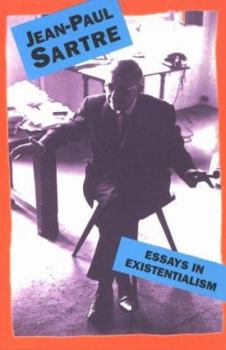Essays in Existentialism
Select Format
Select Condition 
Book Overview
Examination of human consciousness; philosophy, metaphysics, semantics, existentialism. This description may be from another edition of this product.
Format:Paperback
Language:English
ISBN:0806501626
ISBN13:9780806501628
Release Date:June 2000
Publisher:Citadel Press
Length:448 Pages
Weight:1.06 lbs.
Dimensions:1.3" x 5.4" x 8.2"
Customer Reviews
2 ratings
Skip the Tintoretto
Published by Thriftbooks.com User , 18 years ago
Rather than tackle Being & Nothingness (B & N) straightaway, the curious reader interested in exploring Sartre may find this volume a good introduction and preparation before deciding to take on B & N. In fact the first section of this book is actually taken from B & N. The Citadel Press version of B & N is definitely a more reader-friendly book than the Washington Square Press version: the type is cleaner and bigger; the paper is better quality; and the book is just overall better-looking. Unfortunately, it is an abridged version. One entire beginning section has been excised and placed into this volume as Section I. The rationale for this move (as far as I can tell) was that Sartre had republished this particular section at a later date in another volume of essays, incorporating some minor revisions. It amounts to some 60 or so pages of text. Citadel apparently chose to publish only the later version of the text in this volume of essays and cut it out of their edition of B & N. At any rate, reading this first section will give you a generous foretaste of B & N. The second section is titled "A Sketch on the Theory of Emotions", an early essay that pre-dates B & N by some ten years. As Robert Solomon has written in his excellent book of essays, "From Hegel to Existentialism", this essay provides a comprehensive introduction to B & N in its own right, and is far clearer than the "oqaque" Introduction of B & N itself. It explains Sartre's theory of emotions, a theory he continued to hold throughout his life, even though he never got around to fleshing it out. (Incidentally, Solomon's book provides a penetrating critique of this essay, and is highly recommended.) The third section is on mental imaging. I found this particular essay to be fascinating reading. It is an exploration of how the mind grapples with difficult concepts by creating mental images of them to help it conceptualize and assimilate them. The final section of essays is on aesthetics, and was for me the most tedious and uninteresting of the lot. In particular the essay on the Renaissance painter Tintoretto was an absolute chore to read. Sartre psychoanalyses Tintoretto, and really seems to go over the top in analyzing his mind and historical situation. The essay seems to go on forever, is repetitious, and drifts aimlessly. Jean Wahl's Introduction to Existentialism appears at the beginning of this volume. It was an address which he delivered to various professors in 1946. It is a gentle, sympathetic, non-rigorous introduction, covering all the major figures and themes. Wahl does an excellent job of explaining just what existentialism is. You will, for example, learn exactly what is meant by the phrase "existence precedes essence." All in all, this book provides a great introduction to Sartre's writing.
Don't miss this book, it will change your life!!!
Published by Thriftbooks.com User , 25 years ago
The scientific study of human nature is primarily a semantic one. This book is a wonderful analysis of consciousness and existence. Check this one out. To Sarte, tally hoe!!!!!!






